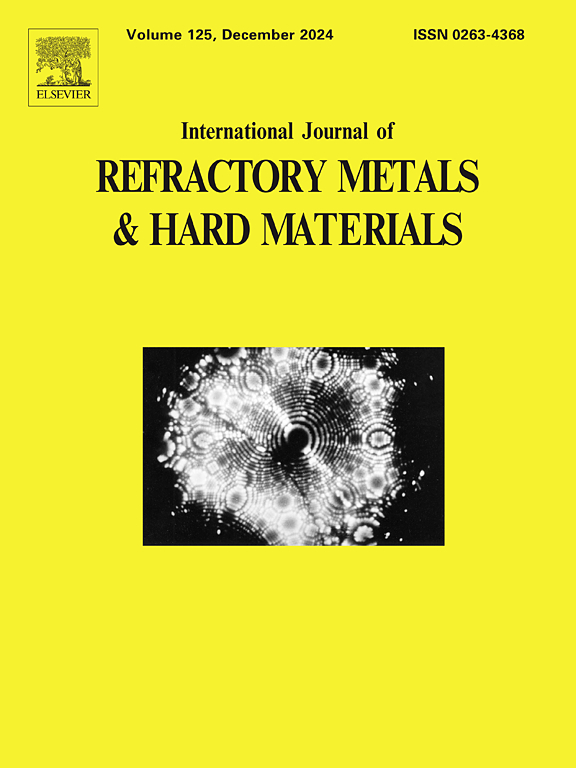采用新颖的铝还原工艺,精确制备了具有指定成分的VAl主合金
IF 4.6
2区 材料科学
Q2 MATERIALS SCIENCE, MULTIDISCIPLINARY
International Journal of Refractory Metals & Hard Materials
Pub Date : 2025-05-21
DOI:10.1016/j.ijrmhm.2025.107244
引用次数: 0
摘要
钒母合金是生产高质量钛合金必不可少的原料,一般采用铝热还原、金属渣重力分离法制备。传统方法存在反应温度过高、炉渣中有金属夹杂、一次制备高铝含量合金困难等问题。为了解决这些问题,本研究报告了一种新的方法来精确制造具有指定成分的VAl母合金,即铝还原与酸浸工艺相结合。确定了弱酸溶性铝酸钙的还原副产物、铝还原的关键参数和反应路线。本研究表明,通过将V2O3 + (2 + 2x-)/xAl + 2.0CaO + 1.35CaCl2(摩尔比)的最佳混合物在1000℃的氩气中加热5 h,并使用pH控制在1.2的HCl酸酸洗还原材料,成功制备了各种VAl中间合金(以AlVx表示)。6Al4V、4Al6V和2Al8V合金粉末中的氧含量分别为400 ppm、500-700 ppm和1800-2000 ppm。用这种方法生产的4Al6V粉末与工业生产的4Al6V粉末相比,具有相似的相和化学成分,但在粉末冶金烧结中具有更细的尺寸。加热过程中发生的主要反应或相变包括:CaCl2中表面和结晶水的逐步去除、Al的熔化、V2O3与CaO的反应、CaO-CaCl2二元化合物的熔化和Al的还原反应。本研究开发的方法也可用于制备其他合金,如TiAl和TiFe合金粉末。本文章由计算机程序翻译,如有差异,请以英文原文为准。
Precise fabrication of VAl master alloy with a designated composition by a novel Al reduction process
V![]() Al master alloys are essential raw materials for producing high-quality titanium alloys, which are generally produced by aluminothermic reduction, metal-slag gravitational separation method. The conventional way faces the challenges of excessively high reaction temperatures, metallic inclusions in slag, and difficulties in fabricating higher-Al-content alloy in one step. To conquer these issues, this research has reported a new method to precisely fabricate V
Al master alloys are essential raw materials for producing high-quality titanium alloys, which are generally produced by aluminothermic reduction, metal-slag gravitational separation method. The conventional way faces the challenges of excessively high reaction temperatures, metallic inclusions in slag, and difficulties in fabricating higher-Al-content alloy in one step. To conquer these issues, this research has reported a new method to precisely fabricate V![]() Al master alloy with a designated composition, which is an aluminum reduction coupled with an acid leaching process. The reduction byproduct of weak-acid-soluble calcium aluminate, the critical parameters for Al reduction, and the reaction routes are determined. This research has demonstrated that various V
Al master alloy with a designated composition, which is an aluminum reduction coupled with an acid leaching process. The reduction byproduct of weak-acid-soluble calcium aluminate, the critical parameters for Al reduction, and the reaction routes are determined. This research has demonstrated that various V![]() Al master alloys (expressed as AlVx) are successfully prepared by heating the optimal mixture of V2O3 + (2 + 2x-)/xAl + 2.0CaO + 1.35CaCl2 (in molar ratio) at 1000 °C for 5 h in Ar and pickling the reduction material using HCl acid with pH controlled at 1.2. Oxygen in 6Al4V, 4Al6V, and 2Al8V alloy powders are 400 ppm, 500–700 ppm, and 1800–2000 ppm, respectively. The 4Al6V powder produced by this reported method is compared with the commercial one, with comparable phase and chemical compositions but with finer sizes preferred in powder metallurgy sintering. The main reactions or phase changes that happen during heating include stepwise removal of surface and crystalline water from CaCl2, melting of Al, reaction between V2O3 and CaO, melting of CaO-CaCl2 binary compound, and Al reduction reaction. The method developed in this study can also be used to prepare other alloys, such as Ti
Al master alloys (expressed as AlVx) are successfully prepared by heating the optimal mixture of V2O3 + (2 + 2x-)/xAl + 2.0CaO + 1.35CaCl2 (in molar ratio) at 1000 °C for 5 h in Ar and pickling the reduction material using HCl acid with pH controlled at 1.2. Oxygen in 6Al4V, 4Al6V, and 2Al8V alloy powders are 400 ppm, 500–700 ppm, and 1800–2000 ppm, respectively. The 4Al6V powder produced by this reported method is compared with the commercial one, with comparable phase and chemical compositions but with finer sizes preferred in powder metallurgy sintering. The main reactions or phase changes that happen during heating include stepwise removal of surface and crystalline water from CaCl2, melting of Al, reaction between V2O3 and CaO, melting of CaO-CaCl2 binary compound, and Al reduction reaction. The method developed in this study can also be used to prepare other alloys, such as Ti![]() Al and Ti
Al and Ti![]() Fe alloy powders.
Fe alloy powders.
求助全文
通过发布文献求助,成功后即可免费获取论文全文。
去求助
来源期刊
CiteScore
7.00
自引率
13.90%
发文量
236
审稿时长
35 days
期刊介绍:
The International Journal of Refractory Metals and Hard Materials (IJRMHM) publishes original research articles concerned with all aspects of refractory metals and hard materials. Refractory metals are defined as metals with melting points higher than 1800 °C. These are tungsten, molybdenum, chromium, tantalum, niobium, hafnium, and rhenium, as well as many compounds and alloys based thereupon. Hard materials that are included in the scope of this journal are defined as materials with hardness values higher than 1000 kg/mm2, primarily intended for applications as manufacturing tools or wear resistant components in mechanical systems. Thus they encompass carbides, nitrides and borides of metals, and related compounds. A special focus of this journal is put on the family of hardmetals, which is also known as cemented tungsten carbide, and cermets which are based on titanium carbide and carbonitrides with or without a metal binder. Ceramics and superhard materials including diamond and cubic boron nitride may also be accepted provided the subject material is presented as hard materials as defined above.

 求助内容:
求助内容: 应助结果提醒方式:
应助结果提醒方式:


